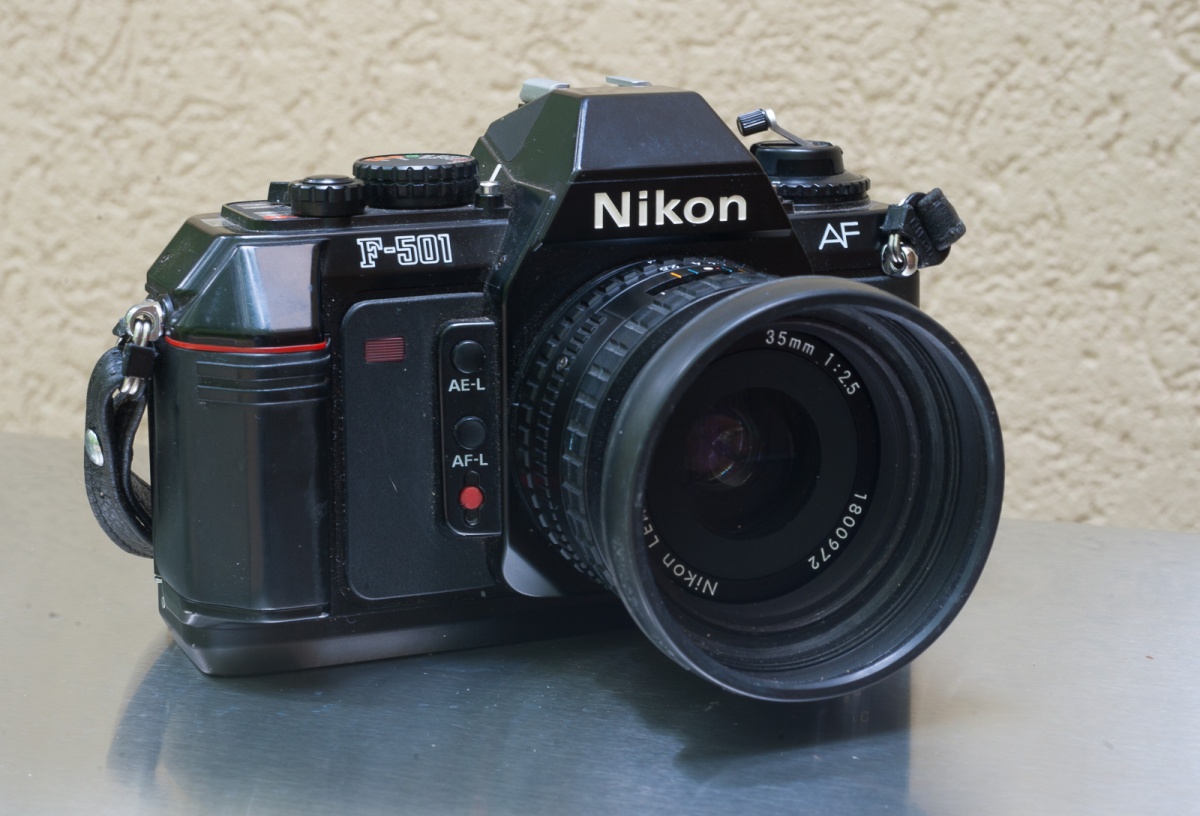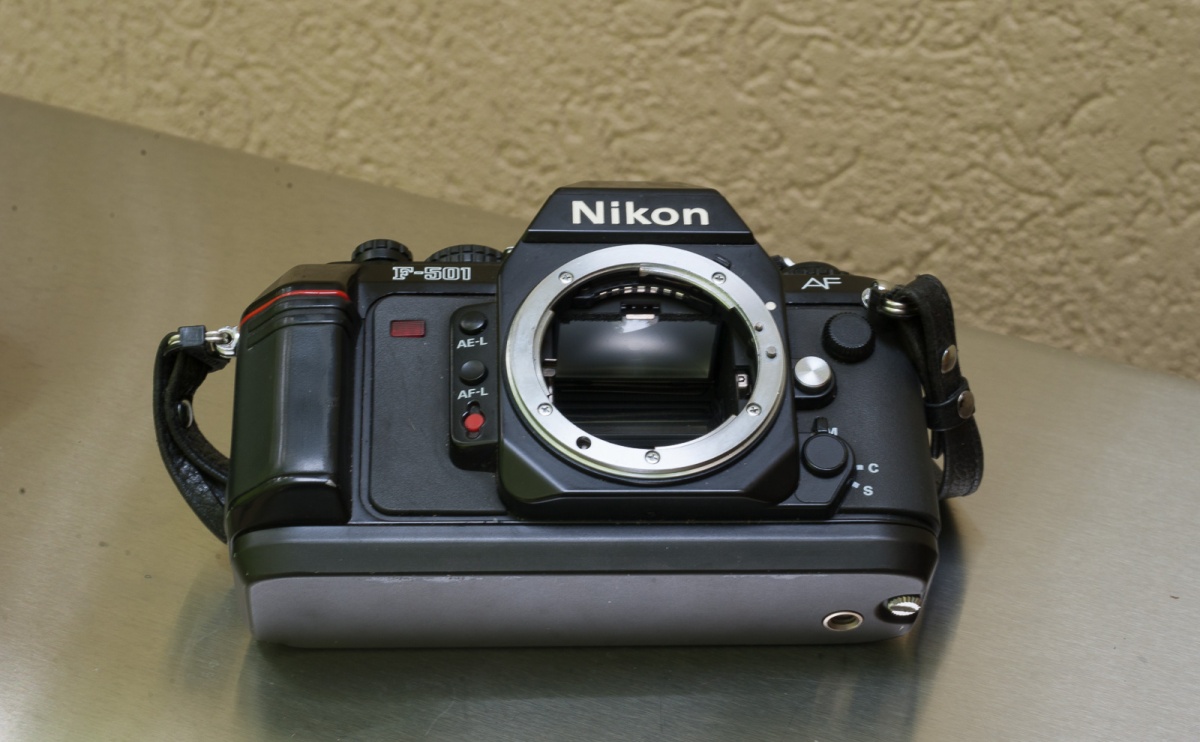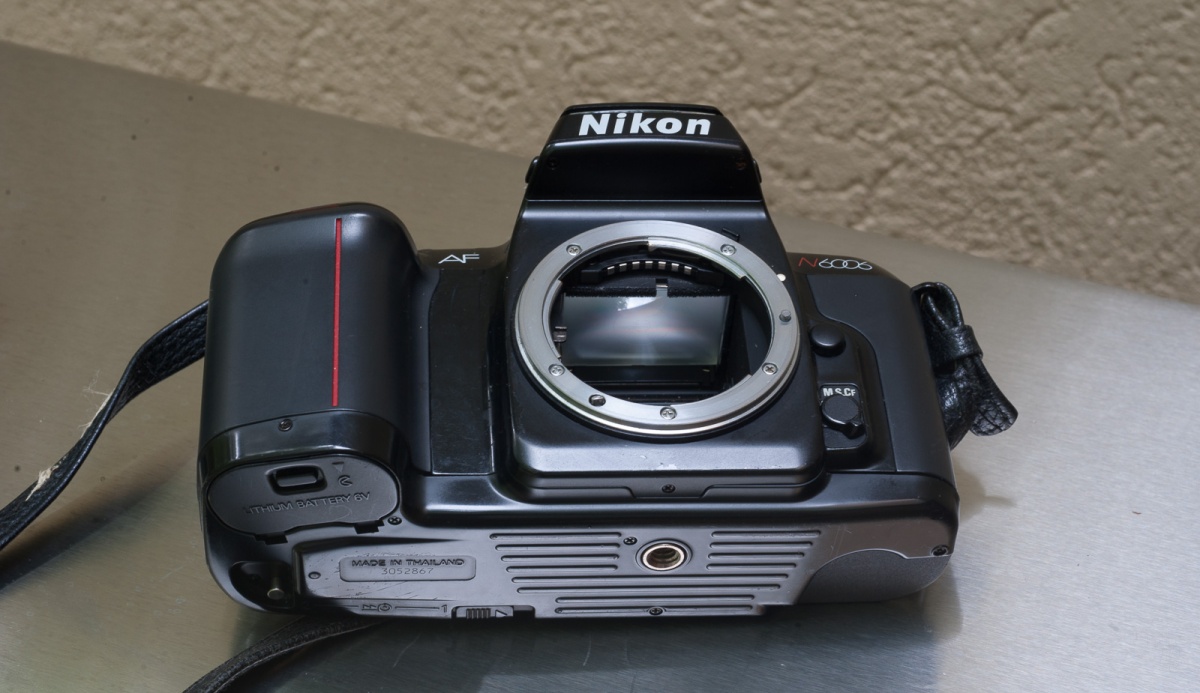The N2020 (F-501 outside of the US) was Nikon’s first mass market auto-focus SLR. It was an upgrade of the N2000 (F-301 “in the rest of the world”), Nikon’s first SLR with an integrated motor. They inaugurated a new type of laser etched focusing screen, and a new camera naming scheme based on numbers. Because they had the two lowest numbers in the hierarchy, they were often mistaken for low performance entry-level models.

It’s obviously a wrong perception: just consider the price of the N2020 – a few years after being launched, it was still more expensive than Minolta’s enthusiast oriented Maxxum 7000, in the same ballpark as the ground breaking Canon EOS 650, itself derived from the very high-end and very expensive Canon T90.
Like the Nikon F4 that would follow two years after (and contrarily to the Minolta and Canon auto-focus cameras), the N2020 retained conventional commands (shutter speed knob, aperture ring, ISO speed dial), and, as a true high-end Nikon, protected the photographers from unfortunate lapses of attention with all sorts of locks and flashing red LEDs.
Nikon’s transition to auto-focus
At the end of 1985, Nikon was apparently not certain that their (generally technically conservative) customers would enthusiastically embrace auto-focus, and they edged their bets. They first launched a manual focus version of their new body, the N2000 (*), and took their time to fine tune the auto-focus version, the N2020, finally presented in April 1986. They were not certain that the photographers would adjust to motorized film advance either, so they kept a conventional rewind crank. The N2000 and the N2020 could read DX coding, but still had a conventional film sensitivity selector. Just in case. This prudent approach extended to the design as well. Nikon did not go for a full poly-carbonate body with rounded edges, they kept an hybrid metal/plastic construction with a design language based on sharp angles. Do you start seeing a pattern here?

Yes, the auto-focus of the N2020 is primitive – with only 96 photosites (the following generation launched in 1988 with the N8080 and the F4 had a new sensor with 200 photo sites). Strangely enough, the auto-focus area at the center of the viewfinder does not feel as narrow as it does on the F4, but it’s far less sensitive in low light, making it almost unusable indoors.

By today’s standards, it’s more of a focus-assist system than a true auto-focus, but because there was a version of the same camera without auto-focus, the viewfinder retains the characteristics of manual focus cameras (92% coverage, 85% magnification, precise and relatively grainy focusing screen). It is still suited to manual focusing, even though the default focusing screen of the N2020 is deprived of a micro-prism ring. Other focusing screens (including the very sought after K type with a micro-prism ring surrounding a split image telemeter spot) may still be available – but as far as I know the model is specific to the N2020 and I could not find any on eBay.


Everyday use
The N2020 (in fact, mine is a “rest-of-the-world” F501) is the camera that I had brought with me – virtually untested – to a long trip to Israel, Jordan and France. The camera did not miss a beat, and fulfilled its mission brilliantly.

It does not exude from the N2020 the impression of quality that emanates from a Nikon FE2, a F3 or a F4, but it still feels less of an amateur photographer camera than the Nikon FG. Compared to the FG, it’s larger and heavier, and receives a faster shutter (1/2000sec) and an exposure memory lock button (more useful than the +2EV button of the FG). Like the current pro cameras from Nikon, it can be controlled via a wired remote. The back has a window showing the film cartridge, a film advance indicator, and a red LED warns the photographer if the DX sensitivity coding can not be read. Clearly not a body for the experts or the pros (roles that would be fulfilled in Nikon’s product range by the N8008/F801 and the high-end F4 respectively), but not a simplified or spec’d down entry level camera either.

If you don’t forget it’s a very early auto-focus camera, and don’t expect it to behave like a Nikon F6, it’s a pleasant camera to use. On the plus side:
- the ergonomics – simple, easy to learn, no menus, no hidden functions, just conventional knobs and rings
- the conventional Nikon average weighted metering – that is to say: accurate and predictable (at least as long as the cell is not blinded by the middle-eastern sun)
- its relatively compact size
- it works with any Nikon AI, AI-S, AF or AF-D lens without any limitation (the lens mount has all the sensors and pins of a true AI-S camera).
- Exposure determination can be left to one of the three program modes, or controlled more directly by the photographer (aperture preferred auto-exposure and manual modes)
- It runs on standard AAA or AA batteries (the AA battery tray was optional)
- it’s reliable – it simply works, with no known mechanical or cosmetic issues.
Not everything is perfect: the viewfinder is informative, bright, but rather narrow, with a relatively short eye-point (the same as the FG or FM-FE), the winder is rather loud, and of course its auto-focus system dramatically lacks sensitivity in low light – it is almost unusable indoors if the scene is not lit like a studio. But it’s not too much of an issue today : even with its standard focusing screen, the N2020 is one of the few auto-focus SLRs that can still really be used with manual focus lenses – at least with wide angle lenses.

How much?
Today, early auto-focus cameras are dirt cheap, and this one is not different. Very nice copies can be had for $35.00 in specialized second-hand photo equipment stores, and will not fetch more than a few dollars on eBay or at Goodwill.
As a conclusion
Like the F4 in the “pro” market, the N2020 is at the same time Nikon’s last “enthusiast” body with a conventional user interface, and the first of a long line of auto-focus and motorized SLRs.
Its conventional user interface is well thought and makes for a pleasant experience, and its high-magnification viewfinder is better suited than the F4’s for manual focus operations. The N2020 is also reasonably light and compact (half the weight of the F4 with its MB-21 grip), but of course you can’t compare a camera designed for amateurs with a high-end professional rig.

It would not be reasonable to buy a N2020 and expect it to deliver the performance of a more modern auto-focus SLR. With its simple and narrow auto-focus sensor, its limited processing power and its weak focus motor, it can’t even compete with a F4, let alone a N90s or any auto-focus film SLR manufactured in the mid to late nineties. But if you see it as a manual focus camera with a focus-assist system, it becomes much more enjoyable.
The manual focus E Series lenses are a very good fit for the N2020. Designed originally for the EM, the lenses are built out of plastic with a simplified optical formula (to save on weight and contain cost), but some of the E lenses (the 50mm f/1.8 or the 35mm f/2.5 for instance) are probably as good optically as the metal-built Nikkor lenses of equivalent aperture. Nikon’s first consumer grade (sliding aperture) 35-70mm auto-focus zooms have a bad reputation, but the 28-70 AF f/3.5-4.5 that followed a few years later is very compact and sharp – a little known gem.
With a manual focus prime lens or a small auto-focus zoom (like the 28-70 F/3.5-4.5 mentioned above), the N2020 will form a cheap, reliable, compact and highly capable set, to be used to learn the basics of photography, or as a second body for the occasions when a more expensive camera can not be risked.
(*) In 1990, Nikon did it again- they replaced the F301-F501/N2000-N2020 series with two cameras – one with an improved auto-focus system (the F601/N6006), one with manual focus (F601m, N6000).
Another opinion (not that different, in fact) about the N2020: http://randomphoto.blogspot.com/2018/03/nikon-took-af-mainstream-n2020-slr.html
An interesting perspective: a comparison of the Nikon ELW, N2020 and N90s: http://www.mikeeckman.com/2017/01/three-decades-of-nikons/
To learn more about the theory of auto-focus: http://www.exclusivearchitecture.com/?page_id=980
Our best source (bar Nikon themselves) about the Nikon system in the 1970-1990 era has very little about the N2020/F-501, but there is one interesting page dedicated to the 28-70 AF zoom: Photography in Malaysia (MIR): a page about the Nikon 28-70 AF f/3.5-4.5
